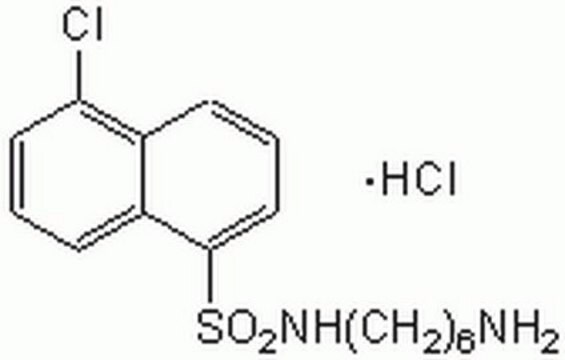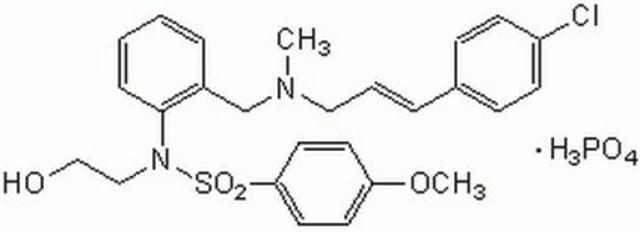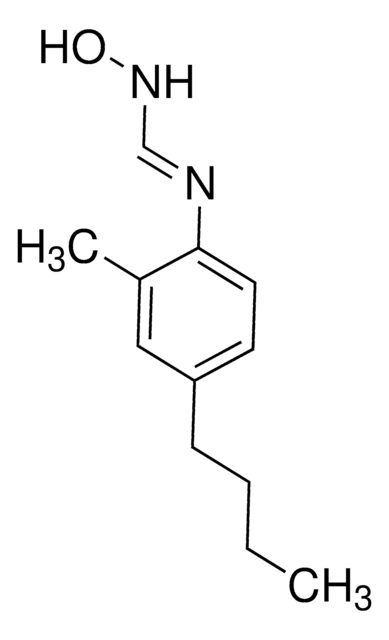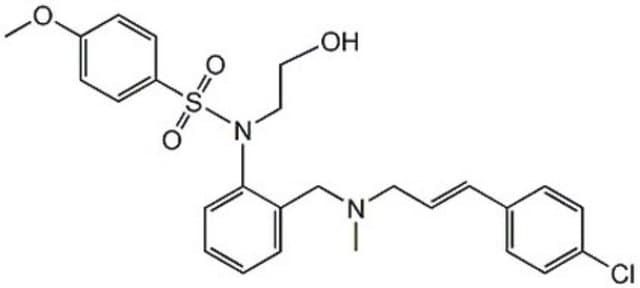422706
KN-62
A cell-permeable, reversible, and selective inhibitor of CaM kinase II (Ki = 900 nM for rat brain CaM kinase II) that binds directly to the calmodulin binding site of the enzyme.
Synonyme(s) :
KN-62, 1-[N,O- bis-(5-Isoquinolinesulfonyl)-N-methyl-L-tyrosyl]-4-phenylpiperazine, P2X Antagonist II, Purinergic Receptor P2X Antagonist II, 1-[N,O-bis-(5-Isoquinolinesulfonyl)-N-methyl-L-tyrosyl]-4-phenylpiperazine, P2X Antagonist II, Purinergic Receptor P2X Antagonist II
About This Item
Produits recommandés
Niveau de qualité
Pureté
≥95% (HPLC)
Forme
solid
Fabricant/nom de marque
Calbiochem®
Conditions de stockage
OK to freeze
desiccated
protect from light
Couleur
off-white
Solubilité
methanol: 5 mg/mL
DMSO: soluble
Conditions d'expédition
ambient
Température de stockage
2-8°C
InChI
1S/C38H35N5O6S2/c1-41(50(45,46)36-11-5-7-29-26-39-19-17-33(29)36)35(38(44)43-23-21-42(22-24-43)31-9-3-2-4-10-31)25-28-13-15-32(16-14-28)49-51(47,48)37-12-6-8-30-27-40-20-18-34(30)37/h2-20,26-27,35H,21-25H2,1H3
Clé InChI
RJVLFQBBRSMWHX-UHFFFAOYSA-N
Description générale
Actions biochimiques/physiologiques
cam kinase 2
Avertissement
Notes préparatoires
Reconstitution
Autres remarques
Kato, M., et al. 1992. Neurosci. Lett.129, 47.
Ishii, A., et al. 1991. Biochem. Biophys. Res. Commun.176, 1051.
Ito, I., et al. 1991. Neurosci. Lett.121, 119.
Tokumitsu, H., et al. 1990. J. Biol. Chem.265, 4315.
Informations légales
Code de la classe de stockage
11 - Combustible Solids
Classe de danger pour l'eau (WGK)
WGK 3
Point d'éclair (°F)
Not applicable
Point d'éclair (°C)
Not applicable
Certificats d'analyse (COA)
Recherchez un Certificats d'analyse (COA) en saisissant le numéro de lot du produit. Les numéros de lot figurent sur l'étiquette du produit après les mots "Lot" ou "Batch".
Déjà en possession de ce produit ?
Retrouvez la documentation relative aux produits que vous avez récemment achetés dans la Bibliothèque de documents.
Notre équipe de scientifiques dispose d'une expérience dans tous les secteurs de la recherche, notamment en sciences de la vie, science des matériaux, synthèse chimique, chromatographie, analyse et dans de nombreux autres domaines..
Contacter notre Service technique








